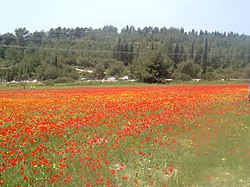| Papaver umbonatum | |
|---|---|
 | |
| Scientific classification | |
| Kingdom: | Plantae |
| Clade: | Tracheophytes |
| Clade: | Angiosperms |
| Clade: | Eudicots |
| Order: | Ranunculales |
| Family: | Papaveraceae |
| Genus: | Papaver |
| Species: | P. umbonatum |
| Binomial name | |
| Papaver umbonatum | |
| Synonyms [1] | |
Papaver stylatumBoiss. & Balansa Contents | |
Papaver umbonatum is a species of flowering plant in the family Papaveraceae. [1] [2] This species is also known more commonly as bossed or Semitic poppy. [3] It is often misidentified as Papaver rhoeas (corn poppy, common in Europe), since they are very similar in form and appearance. Its native range includes the rocky plains of Turkey, Syria, Lebanon, Israel, and the Palestinian Territories. [1] [4]


